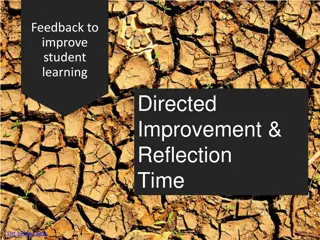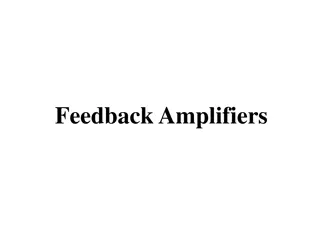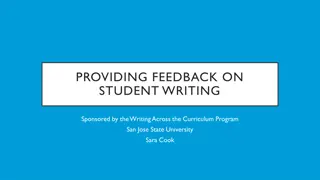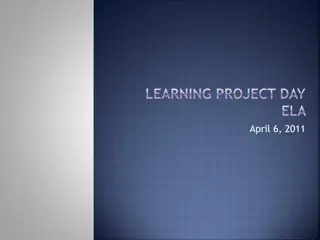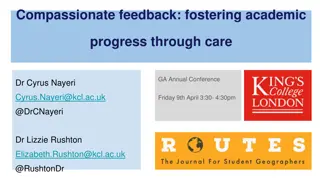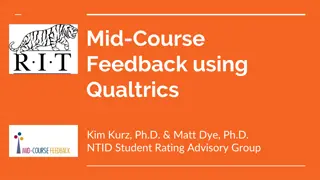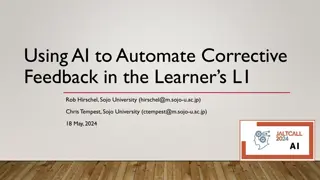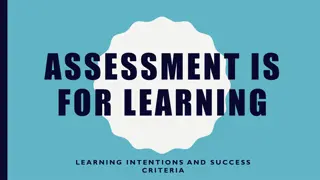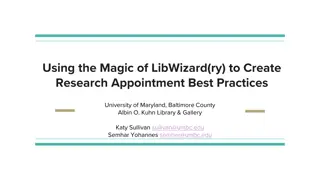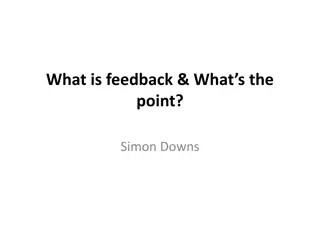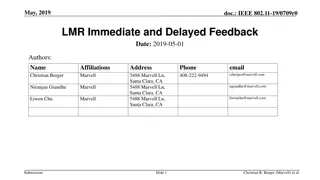Enhancing Online Learning Through Effective Feedback Strategies
Explore the strategies and tools used by educators like Sydney Curtis, Minerva Ahumada, and Linda Kurtos to provide valuable feedback in online classes. Learn how they set expectations, manage time, and encourage student engagement through platforms like Sakai Forums. Discover lessons learned and the importance of early feedback to improve student learning outcomes.
Download Presentation

Please find below an Image/Link to download the presentation.
The content on the website is provided AS IS for your information and personal use only. It may not be sold, licensed, or shared on other websites without obtaining consent from the author.If you encounter any issues during the download, it is possible that the publisher has removed the file from their server.
You are allowed to download the files provided on this website for personal or commercial use, subject to the condition that they are used lawfully. All files are the property of their respective owners.
The content on the website is provided AS IS for your information and personal use only. It may not be sold, licensed, or shared on other websites without obtaining consent from the author.
E N D
Presentation Transcript
Feedback in Online Classes Sydney Curtis Minerva Ahumada Linda Kurtos Marianna (Mare) Swallow Hans Svebakken
Guiding Questions 1. How do you decide how much feedback to give? 2. How do you vary the feedback you give? 3. How do you ask students to use the feedback you give? 4. How do you give feedback efficiently? 5. How do you use technology tools to give feedback? 6. How do you manage time while giving feedback?
Feedback and Sakai Forums Dr. Minerva Ahumada Clinical Associate Professor, Philosophy Arrupe College
The Task Students responded to cases in their Ethics class (ACPHI 281) Before they turned in their final response, students were asked to submit their responses to Forums on Sakai. Each student then was asked to give feedback to the two students whose responses appeared below. Students had time to incorporate these feedback (and what they learned from their peers) into their final case response (uploaded to Sakai/Assignments).
Setting Expectations Write 3-4 sentences where you address: What they have done well; What they can improve upon; No need to proofread the work for them (but you could suggest that they take a second look at it); Focus on the main aspects of the grading criteria for the case.
Lessons Learned Allows students to learn from one another Students pay more attention to the grading criteria over time Some students wanted more constructive feedback from their peers Optimizes grading time Keep in mind the purpose of the assignment when providing feedback
Providing Feedback Early On Linda Kurtos, JD and MS Assistant Dean for Graduate Programs, Lecturer Institute of Environmental Sustainability
Encouraging Valuable Discussion - Preparing the Student Explanation of what an informed discussion response looks like Expanding on the course content to another application Applying the course content to other areas Supporting citations No I agree responses Grading matrix that further outlines my expectations Activity and frequency Engagement Substantive content
Encouraging Valuable Discussion - Logistical Systems Blind posts Students must respond to a discussion before they can read other student responses Encourages more individualized responses and avoids a culture of one right answer Minimum mandatory responses Students are encouraged by grading system to stay active in the discussion throughout the week. Citations required, but less rigid Students must use reliable sources - NYT articles, not peer-reviewed studies - that allow them to apply the new concepts without being too burdensome Trains students to start seeing the concepts in the world around them
How to Distribute Feedback Early on: focus on grading expectations. Great work, _______. Interesting posts with good references and support for them. I appreciate you posting early; it helps develop great discussion. I didn't realize that the dye used for St. Pat's caused problems; a citation would have been useful here, but you did a great job of citing to your other points, so I did not deduct points. Later on: substantive value of content. ______, nice range of discussions this week. Looking at how outside parties can impact law through lawsuits is an important perspective. But also important to note how different Administrations choose to use the input they gather from outside parties who may be in a position to work with them. Student s focus: think more broadly of their work and its impact on others and challenges them to keep improving their posts Professor s focus: better understand the subject matter, gauge their progress in the class and establish a relationship each individual student.
The Personal Touch Provide feedback that is brief, but more personal, rather than provide statements that may be lengthier but more generic.
Feedback in the Real World Prof. Marianna (Mare) Swallow Faculty School of Communication
What is the purpose of the feedback? To improve (obvi!) Give students directives on how to think about and apply the feedback beyond this course.
Guidelines for giving feedback Specific Actionable Honest and Tactful Areas for improvement must be included
Order of feedback 1. What did you like? 2. How can ________ make this better next time?
Minimum feedback & time management Each student receives a minimum of 3 comments from their peers Time management when delivering / taking feedback Have verbiage ready to go
Directive to students... Write down your feedback!!!
Oral Exams Hans Svebakken, PhD Senior Lecturer Department of Theology
Why Oral Exams? Viable option for giving personalized qualitative feedback in real time to highly invested students, A potentially rewarding student experience in the otherwise remote setting of the pandemic. Although oral exams require time, they require little to no written feedback (efficiency).
The Backstory... Effort to improve quality of student experience in assessment(s). Conviction that conversation represents ideal mode of assessment.
The How in General Students qualify for oral exam through performance on Sakai quizzes (91%+). Offer extended to interested qualifying students (others take written exam). Pass or Non-Pass : Passing means quiz average becomes exam score.
The How in Particular Students advance to top of a pyramid of questions (cf. Bloom s Taxonomy). Three strikes and you re out (Non-Pass).
The How in Particular Essay Evaluate & Create Lorem Ipsum Question . Lorem Ipsum Text Question Lorem Ipsum Text Question Apply & Analyze Something Something Something Something Lorem Ipsum Learned Lorem Ipsum Learned Lorem Ipsum Learned Lorem Ipsum Learned Remember & Understand
Reflecting on this Practice Pros: (1) Efficient Feedback (via assessment itself), (2) Student Engagement Cons: (1) Time Commitment, (2) Not Viable for Entire Class
Thanks! Are there any questions from the audience?


